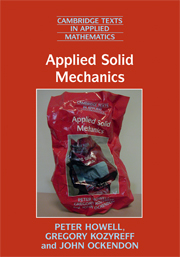Book contents
Modelling solids
Published online by Cambridge University Press: 02 February 2010
Summary
Introduction
In everyday life we regularly encounter physical phenomena that apparently vary continuously in space and time. Examples are the bending of a paper clip, the flow of water or the propagation of sound or light waves. Such phenomena can be described mathematically, to lowest order, by a continuum model, and this book will be concerned with that class of continuum models that describes solids. Hence, at least to begin with, we will avoid all consideration of the “atomistic” structure of solids, even though these ideas lead to great practical insight and also to some beautiful mathematics. When we refer to a solid “particle”, we will be thinking of a very small region of matter but one whose dimension is nonetheless much greater than an atomic spacing.
For our purposes, the diagnostic feature of a solid is the way in which it responds to an applied system of forces and moments. There is no hard-andfast rule about this but, for most of this book, we will say that a continuum is a solid when the response consists of displacements distributed through the material. In other words, the material starts at some reference state, from which it is displaced by a distance that depends on the applied forces. This is in contrast with a fluid, which has no special rest state and responds to forces via a velocity distribution. Our modelling philosophy is straightforward. We take the most fundamental pieces of experimental evidence, for example Hooke's law, and use mathematical ideas to combine this evidence with the basic laws of mechanics to construct a model that describes the elastic deformation of a continuous solid.
- Type
- Chapter
- Information
- Applied Solid Mechanics , pp. 1 - 27Publisher: Cambridge University PressPrint publication year: 2008

